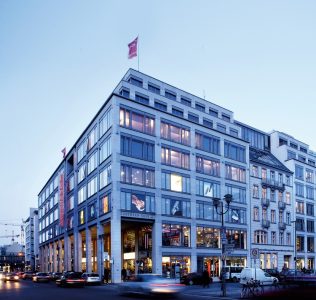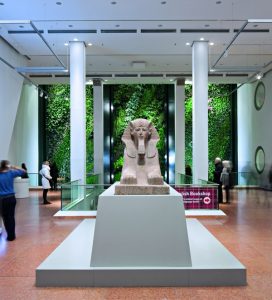Dussmann digital – IoT sensors tending the garden
Issue :
read all articles online
read as pdf
Long-term success only comes to those who continue to develop and deal with new ideas and concepts. The Dussmann Group invests heavily in digitizing its business and administrative processes. The family enterprise stays up to date with developments, such as robots and sensors used to clean buildings, user-friendly apps and smart tableware in catering. Internet of Things (IoT) projects are a part of its strategic, next-level “Dussmann digital” program.

IoT pilot project at the Dussmann Group
The Group IT department, among others, is responsible for this program. The Dussmann Group has been carrying out an IoT project at its global headquarters in Berlin since August 2019. This pilot project involves installing IoT sensors in public areas of the building’s fourth floor, including two conference rooms, the sanitary facilities and the break room.
As part of the “Evaluating sensor-supported cleaning” project, the “vertical garden,” an enormous plant wall, was also equipped with sensors that monitor humidity, light level and water temperature, among other things. The Dussmann Group decided to go with self-powered wireless sensors based on EnOcean technology, which obtain their energy from their immediate surroundings without cables or batteries. For example, a very small solar cell is all that’s required to enable the sensor to send the detected data to the cloud via a gateway.
Vertical garden with a tropicalatmosphere
When visitors enter Dussmann-Haus, the first thing they see is a plant wall measuring 18 meters high and 15 meters wide, which extends over five floors. Designed by the French artist Patrick Blanc, the vertical garden has around 6,700 tropical plants of 157 different species, which grow in a space of 270 square meters without any soil and using a sophisticated irrigation system. Visitors can sit right under the plant wall in a restaurant that is open to the public.

Recording water temperature, water quality, relative humidity and water level reduces the amount of monitoring and maintenance work performed by the Dussmann technician.
Sensors
The project’s strategic goal is to modernize, automate and simplify processes. In the case of the plant wall, a variety of self-powered wireless sensors were used for this purpose. The project has noticeably reduced the amount of maintenance by the company technician when it comes to water temperature, water level and water quality. The technician now has a dashboard customized to his specific needs for maintaining the vertical garden. Since the data is collected continuously, the Dussmann facility management team is notified of critical deviations by email. This ensures the best operating climate – and not only for the plants.
- Purpose of the Light sensors: Plants require certain lighting scenarios for optimum growth. Sensors monitor the light intensity and adapt it to the dormant and growth phases.
- Purpose of the Humidity sensors: Since the plant wall is equipped with an irrigation system and humidity is essential to plant health, appropriate industrial multisensors were selected.
- Purpose of the Water temperature sensors: An optimum water temperature must prevail for the plants’ well-being. Sensors constantly measure the temperature and report the data to the company technician.
- Purpose of the Water level detectors: In the past, water levels occurred that were either too low or too high. Sensors with a soil probe provide information on the fi ll level. For example, they signal when the minimum and maximum water levels have been reached.
New articles in Smart Spaces
Long-term success only comes to those who continue to develop and deal with new ideas and concepts. The Dussmann Group invests heavily in digitizing its business and administrative processes. The family enterprise stays up to date with developments, such as robots and sensors used to clean buildings, user-friendly apps and smart tableware in catering. Internet of Things (IoT) projects are a part of its strategic, next-level “Dussmann digital” program.
IoT pilot project at the Dussmann Group
The Group IT department, among others, is responsible for this program. The Dussmann Group has been carrying out an IoT project at its global headquarters in Berlin since August 2019. This pilot project involves
installing IoT sensors in public areas of the building’s fourth floor, including two conference rooms, the sanitary facilities and the break room.
As part of the “Evaluating sensor-supported cleaning” project, the “vertical garden,” an enormous plant wall, was also equipped with sensors that monitor humidity, light level and water temperature, among other things. The Dussmann Group decided to go with self-powered wireless sensors based on EnOcean technology, which obtain their energy from their immediate surroundings without cables or batteries. For example, a very small solar cell is all that’s required to enable the sensor to send the detected data to the cloud via a gateway.
Vertical garden with a tropical atmosphere
When visitors enter Dussmann-Haus, the first thing they see is a plant wall measuring 18 meters high and 15 meters wide, which extends over five floors. Designed by the French artist Patrick Blanc, the vertical garden has around 6,700 tropical plants of 157 different species, which grow in a space of 270 square meters without any soil and using a sophisticated irrigation system. Visitors can sit right under the plant wall in a restaurant that is open to the public.
New articles in Smart Spaces
Top articles

Microsoft: IoT-Sicherheit in der Cloud





